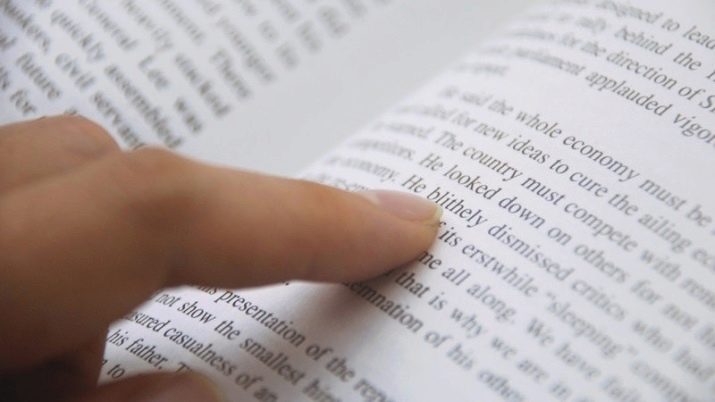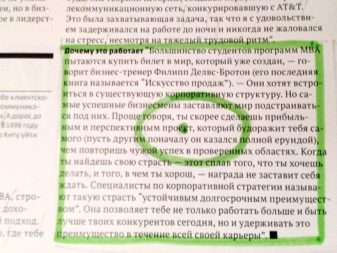Speed reading is a quick text reading skill. Using this technique, any person, whether an adult or a child, can repeatedly expand his field of vision, learn to sift out the unnecessary and highlight the most important information. It is noteworthy that you can learn speed reading even at home, if you regularly engage. We offer you a set of effective exercises and techniques that will allow you to quickly learn this technique and avoid common mistakes.
What prevents fast reading?
Pronunciation "to oneself"
One of the most common problems is that the child reads to himself: that is, he not only moves his lips and tongue, but also reproduces the words in his head, while his eyes can remain at one point. This phenomenon significantly reduces the speed of perception of information and reading.

Limited field of view
This problem is mainly faced by children. The fact is that the children's eye, in comparison with the adult, has a relatively small field of view, that is, the child can only see the picture in front of him.
Unfortunately, there are not many techniques that help eliminate the effect of this factor, however, you can always try to diversify them a bit.
Return to read
The problem for children and adolescents at the time of reading is often the effect of regression. In this case, the eyes constantly return to material that has already been read earlier - this is considered unacceptable. Let's say more: such a defect is eradicated with great difficulty.It is very important not to confuse regression with reception, the latter is the same regression, but it arises with the aim of rethinking the text read or its better assimilation. It can be justified if the child has questions about the material.

Distraction from the text
An important factor is that the vocabulary and general knowledge base of children is small. It turns out that the kid is trying to mentally understand the essence of a word, the meaning of which he does not know, thus, the reading speed decreases. In this situation, it is very important to shorten the path between the text itself and its analysis, for this it is very important to train the perception of information not through hearing, but visually. Well and finally many children suffer from attention deficit hyperactivity disorder.
Such inattention very often makes the children leave the essence of the information, while reading is repeated in a circle several times.
Effective Techniques
We read with a pointer
Unfortunately, it is impossible to prevent the organs of vision from returning to a previously read text; this skill requires constant training. Usually, a pointer is used for this - then the eyes will automatically follow it, without being distracted by other text blocks. However, the first time the student will have to force himself not to look up, it will be difficult for him.
For the very first lessons, it is better to choose a bookmark - it is placed on the read fragment and continues to glance down at the page. The principle here is simple: the upper text will be hidden, so returning to it with your eyes is simply impossible. This is how the automatic skill of the laws of movement only forward is developed.

Articulation suppression
Useful skills for developing quick reading include suppressing articulation. In this case, the pronunciation of words and expressions is minimized and even completely eliminated, since this is what takes most of the time during reading. The fact is that speaking makes the brain process the read data as well as the received speech information. Thus, the functional load on the brain increases, respectively, this reduces the speed of reading.
As practice shows, in order to learn to suppress articulation, you need at least 20 hours of practice using a special exercise: beating a given rhythm with a hand or a pencil.
Green Point Method
To expand the field of perception of information, you need to take a piece of paper with some text and draw a green dot in its center. The student should carefully look at her for 10 minutes, and then try to imagine before going to bed. A similar attention activity should be carried out for two weeks. After that, you can proceed to the next step - begin to consider the text, which is located vertically and horizontally from the point.
At the same time, you need to strive to capture as many words and phrases as you can, you do not need to read them - just see.


Gibberish Training
A very effective exercise that can develop the ability to concentrate and improve thinking is training in the so-called gibberish language (Martian verses). In other words, this is a reading from right to left. To begin with, you can train such skills with the help of palindromes, that is, words and phrases that are read the same from right to left and left to right. For example, “A rose fell on Azora’s paw”, “Kotu is forty days old”, etc. After that, you can start exercises with the most ordinary text.
Reception "upside down"
Significantly increase the speed of reading with a simple exercise - reading a book upside down. Initially, you need to read a small fragment of the text upside down, then return the book to its original state and re-read it. Surely you will immediately feel how much faster and easier you can do it!
Tic-Tac exercise
Quite an original exercise, it assumes that while reading a student it will cover only the beginning of the line and its end, and not every word, as is done with traditional reading. Often this is enough to understand the meaning of the information presented. In addition, it significantly increases the speed of reading.

Diagonal way
Using diagonal reading methods allows you to perceive the read data using various characters and images. Of course, you are unlikely to be able to familiarize yourself with the book of your favorite author in this technique. But for students and pupils, the method can be very relevant. In this case, reading starts from the upper left corner and moves towards the lower right, while the gaze stops at key phrases. In this way, it takes less than 30 seconds to learn each page.
Methodology through the word
The technique is based on the ability to highlight key phrases and words in the text. Thanks to the exercise, the child learns to formulate the main meaning of the data read. Memory can save a larger amount of necessary information in the head, avoiding memorizing facts and descriptions that are not of fundamental importance.
Photo reading
This technique is not suitable for beginners, it can be used by those students who have already mastered the basics of speed reading. The essence of the technique is to study the text at a certain speed. This skill will allow the child in a fairly short time to view a large stream of data and highlight their basic part. Such reading is rather superficial, it is not suitable for the assimilation of information, but is optimal when searching for information.

Vertical
Vertical reading allows you to increase the radius of peripheral vision. During exercise the student’s gaze does not move along a traditional horizontal path, but vertically exactly in the center of the page. Such reading can be mastered using Schulte tables. They look like cards with columns inside which numbers are written. In this case, the numbers can be in random order. - This is one of the most important conditions, it is in it that the development of skills to find the required number consists.
If there is no table at hand, you can take any text, mentally draw a straight vertical line in the center and read the information presented, focusing your eyes on this line. It’s best to start training with narrow texts, such as newspaper columns. As you progress through the training, the text format can be increased.
How to learn for adults on your own?
It should be noted that you can learn speed reading at any age, and if you decide to get this skill as an adult, then your desire is very commendable. This ability will allow you to save a huge amount of time that you can free up for other, equally important matters.. However, adult students will face many difficulties, as they have to overcome already formed habits. This greatly complicates the process of obtaining skills, however, do not despair - if the motivation is strong enough, then you can master the skills of quick reading at any, even very mature age.
Adults can use any of the above methods to develop reading skills, it is best to choose 2-3 methods and alternate them every 10 days.

What methods are suitable for children?
Parents often encounter a problem when a child does not read well at school, this significantly affects the speed of homework, which cannot but affect the overall performance. The situation is aggravated when, moreover, the child is restless and cannot calmly sit at the book. In this case, the salvation may be the development of speed reading techniques.
However today There is no consensus on how old one can begin to master this technique. Some experts advocate an early start of classes, motivating their position by the fact that in high school and high school it will be much more difficult to break the formed reading skills. However, we draw your attention to the fact that for full mental development it is important not only that the baby can read the text, but also understand it. Do not forget about intonation, which is of fundamental importance in assessing the ability to read in elementary school.
Learning to read fast can only begin if the child knows the alphabet and has already learned to read in words, not syllables. That is why, from a logical point of view, the period from 7 to 10 years will be optimal for the development of speed reading skills. At this time, most children can read words well, and in addition, they capture the essence of the text.
The third group of psychologists advises reading speed only after the child is 10-12 years old. It is believed that from this age children begin to remember and understand information with the speed of speech. In addition, at this age it is much better to develop memory, because the student can not only read the text quickly, but also retell it. Anyway - the choice is only for the parents, everyone should proceed from the peculiarities of the development of their child and solve the issue with the start of learning speed reading individually.
Tip: learning to read children quickly will be more effective when combined with pronunciation of tongue twisters.

High speed reading features
It was experimentally found that speed reading contributes significantly to the activation of thought processes. If you are determined to learn the skills of speed reading and at the same time increase the volume and quality of memorization, then first of all you need to assess the complexity of the task and calculate the amount of information. Focus on the reading speed you need. Estimate in advance the approximate amount of time it takes to assimilate the proposed material as firmly as possible. At this time, a certain gap should be allocated for memorization, as well as another one - for the repetition of what is learned.
One of the most effective techniques is figurative grouping.. Its essence lies in the fact that in the proposed text it is necessary to highlight 7 main semantic blocks. For each block, you need to create your own mental image, that is, one or another key picture. Please note that in each picture there should be no more than 7 basic parts. The selected images should be as bright and easy to remember as possible, each image is fixed in short-term memory for about 10-15 seconds - this is enough for information about them to be archived in long-term memory.
Recommendations
Learning to read speed is not a quick process. It requires regular training, constant training and repetition.. If we are talking about an adult, as a rule, his self-motivation is enough to timely perform all the necessary tasks. Children have no such interest, so many parents begin to put pressure on them. This is not necessary, any training should take place only in a playful way. If this requirement is neglected, then in the best case it is possible simply not to achieve the desired result, and in the worst case, to completely discourage the child from learning to read.
It’s not worth sitting for hours, training will be much more effective, which will take 5 minutes, but it will be repeated 4-5 times a day. Keep in mind that in 20 minutes the child’s brain can become very tired, respectively, the material will not be absorbed in the right amount.











